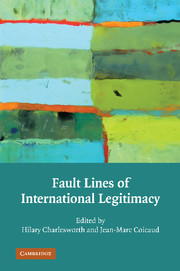Book contents
- Frontmatter
- Contents
- Acknowledgments
- Contributors
- Introduction
- PART I FROM THE HISTORY AND STRUCTURE OF INTERNATIONAL LEGITIMACY TO FAULT LINES IN CONTEMPORARY INTERNATIONAL POLITICS
- PART II THE UN SECURITY COUNCIL: EXPRESSION, VENUE, AND PROMOTER OF INTERNATIONAL LEGITIMACY?
- 6 Legal Deliberation and Argumentation in International Decision Making
- 7 The UN Security Council, Regional Arrangements, and Peacekeeping Operations
- 8 The Security Council's Alliance of Gender Legitimacy: The Symbolic Capital of Resolution 1325
- PART III LEGITIMACY OF INTERNATIONAL INTERVENTIONS AND HIERARCHY OF INTERNATIONAL RIGHTS
- PART IV IN SEARCH OF NEW FORMS OF INTERNATIONAL LEGITIMACY: BETWEEN POWER AND PRINCIPLES
- Conclusion: The Legitimacies of International Law
- Index
- References
8 - The Security Council's Alliance of Gender Legitimacy: The Symbolic Capital of Resolution 1325
Published online by Cambridge University Press: 06 April 2010
- Frontmatter
- Contents
- Acknowledgments
- Contributors
- Introduction
- PART I FROM THE HISTORY AND STRUCTURE OF INTERNATIONAL LEGITIMACY TO FAULT LINES IN CONTEMPORARY INTERNATIONAL POLITICS
- PART II THE UN SECURITY COUNCIL: EXPRESSION, VENUE, AND PROMOTER OF INTERNATIONAL LEGITIMACY?
- 6 Legal Deliberation and Argumentation in International Decision Making
- 7 The UN Security Council, Regional Arrangements, and Peacekeeping Operations
- 8 The Security Council's Alliance of Gender Legitimacy: The Symbolic Capital of Resolution 1325
- PART III LEGITIMACY OF INTERNATIONAL INTERVENTIONS AND HIERARCHY OF INTERNATIONAL RIGHTS
- PART IV IN SEARCH OF NEW FORMS OF INTERNATIONAL LEGITIMACY: BETWEEN POWER AND PRINCIPLES
- Conclusion: The Legitimacies of International Law
- Index
- References
Summary
The Security Council recognizes that peace is inextricably linked with equality between women and men…[and] that the equal access and full participation of women in power structures and their full involvement in all efforts for the prevention and resolution of conflicts are essential for the maintenance and promotion of peace and security.
– Ambassador Anwarul Karim Chowdury (2000) President, UN Security CouncilRecent feminist efforts to engage with the United Nations (UN) Security Council could be dismissed as a futile attempt to employ the “master's tools” to dismantle the “master's house.” There is a long history of lip service by international institutions to the antimilitaristic ways of thinking that have been at the heart of women's peace movements for centuries. However unlikely it was, these efforts have borne fruit as evidenced by the Statement of the Council's President, Bangladeshi Ambassador Chowdury, on International Women's Day in 2000, linking gender equality “inextricably” with peace, the core project of the UN. The Statement was followed several months later, on October 31, by the Council's unanimous adoption of Resolution 1325 on Women, Peace, and Security. The resolution calls for inter alia the increased participation of women in decision making related to the prevention, management, and resolution of armed conflict. Although it is nonbinding, the resolution has been enormously productive. Not only has it provided the basis for strengthening institutional commitment to gender mainstreaming and continuing annual dialogue between women's peace advocates and the Security Council in New York, it has also supplied leverage for many grassroots women's groups to claim a role in peace negotiations and postconflict decision making.
- Type
- Chapter
- Information
- Fault Lines of International Legitimacy , pp. 239 - 276Publisher: Cambridge University PressPrint publication year: 2010
References
- 6
- Cited by

